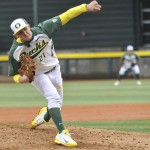Standing in the office window watching relentless rain pelt the garage roof, my mind wanders, savoring the memory of Tuesday’s doubleheader sweep of Seattle University by the men of Ducks Baseball. It occurred to me that many fans may not always understand the nuances of the information being provided by play-by-play announcers as they keep us abreast of what is happening on the field, in particular pitching descriptions.
Pitching is and and always will be the primary focus of anyone watching or listening to a baseball game. Every circumstance or action in a baseball game starts with the pitched ball, thus the focus of any media announcer will logically be upon the work of the pitcher.
We hear the announcer or see a pitch and we are given the description as, “fastball, low and inside” or “a breaking pitch over the outside corner.” And some might think “What are these pitches – what does it mean when the announcer says “fastball”, “breaking pitch” or “change-up?” How does he DO that?
Again, a short answer – he is changing how he grips the baseball and the delivery motion used to throw it to the plate, in an effort to deceive the mind and hand-eye coordination of the batter.
“Wait a minute,” the fan will say, “It is clear the pitcher is winding up, stepping forward and throwing as hard as he can every time.” Are you telling me the ball is not getting to the plate as fast as possible on each pitch?”
The simple answer is ‘yes,’ however, this requires further explanation, beginning with velocity. The velocity of the ball is a function of how the baseball is held by the pitcher at the time of release plus inertia provided by the push off the pitcher’s toe plate. We are not going into the minutia of how the ball is gripped, but we will identify the type of grip and the resulting speed or movement after the pitcher’s release.
In today’s examination, we are going to look at fastballs because, when the great Ducks pitching staff is discussed, throwing heat is what they’re known for. The first characteristic usually mentioned in regard to a players’ fastball is, not coincidentally, its velocity. The velocity is the speed of a pitch on its path to the plate and is measured in mph.
There are a number of fastball grips but the most prevalent are the 2- and 4-finger grips. Oregon’s pitching staff is a strong armed bunch with hurlers such as Brando Tessar, Matt Krook and Stephen Nogosek, who will throw at speeds grater than 90 mph. However, they also throw fastballs in the 87- or 88-mph range.
Do not assume that the slower balls are thrown with less delivery strength, rather, the reduced speed usually results from a 2-finger grip. The 2-finger fastball grip will generally produce a fastball of less velocity, but greater movement, as it reaches the plate. By movement we mean a right, left or downward change in the pitches direction of travel, and that course is also affected by whether the throw is from a left or right hander.
A particularly challenging type of fastball is the rising fastball or “riser.” As one sits in the dugout, batters return from the plate talking about the rise on an opposing pitcher’s fastball.
In our college days, the smart guys in the physics lab told me there is no way a pitcher throwing overhand could produce the required backspin on a ball which would cause it to rise or move in an upward direction. I may have been a somewhat delusional hitter but I swear, on my beloved grandmother’s apron, that I swung at and missed many rising fastballs.
Until next time – see you at beautiful PK Park for the Ohio State series: Friday, March 7th @ 6 p.m., Saturday, March 8th @ 4 p.m. and Sunday, March 9th @ noon.
Gar says, “Take two and hit deep to right!”
Top photo by Kevin Cline
Related Articles:
Chip Kelly Update: Everything's Good Again ...
Chip Kelly Update: Wailing and Gnashing of Teeth
Shock and Awe -- The Oregon Ducks' Football Hangover Effect
Despite Lopsided Score, Georgia State "Never Stopped Believing"
Hope Springs Eternal for Ducks
Incompetent Pac-12 Officials: How Do You Miss ALL of THIS?
Gar is a businessman, writer, father of 4 very successful children and an enthusiastic life long Duck follower. He remembers being a fair country boy athlete and spent a summer playing baseball in the Dodger organization. Playing is using the term loosely as he remembers primarily being asked to carry the equipment to the bus. He has spent 20 years assisting FEMA in providing Housing for disaster victims.



